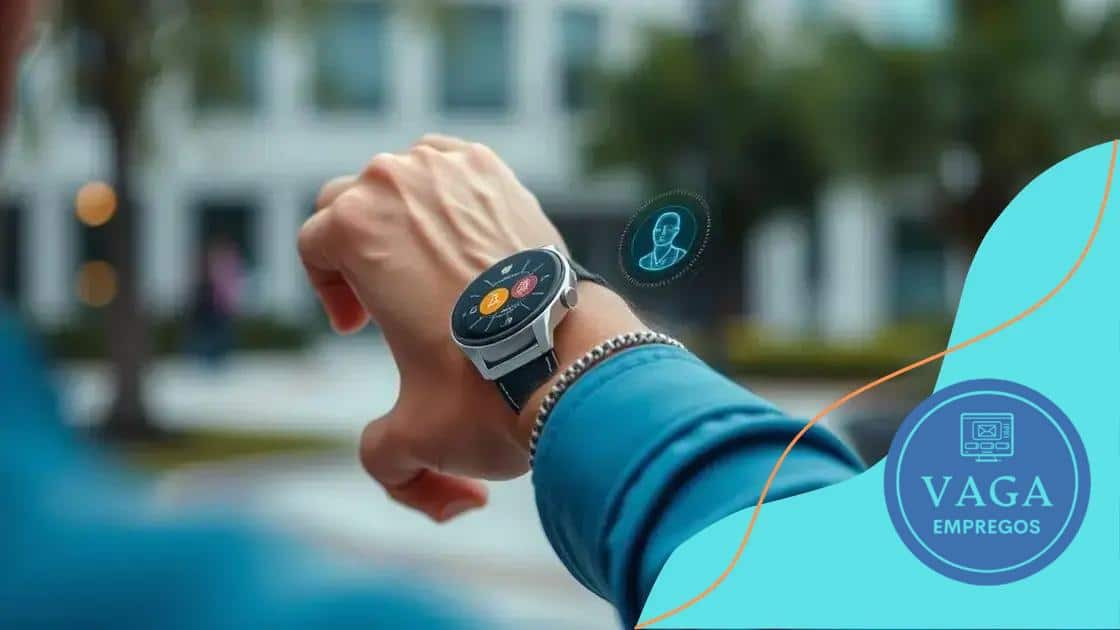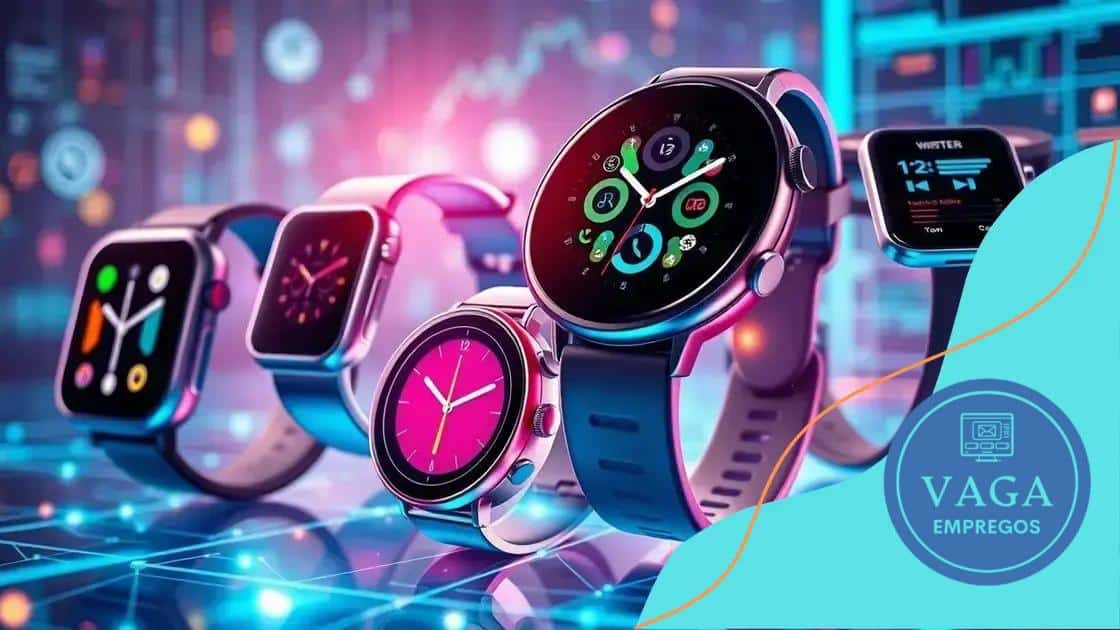Wearable tech evolves with biometric AI interfaces

Advertisement
Wearable tech evolves with biometric AI interfaces, enhancing security, personalization, and health monitoring, while addressing challenges in privacy and data accuracy for improved user experience.
Wearable tech evolves with biometric AI interfaces is reshaping how we interact with technology every day. Have you noticed how your smartwatch can now track your heart rate or monitor your stress levels? Let’s dive deeper into this fascinating evolution.
Advertisement
Understanding biometric AI in wearable tech
Understanding biometric AI in wearable tech is essential as these technologies become more integrated into our daily lives. With advancements in biometric sensors, users can now benefit from personalized experiences based on their unique physiological data. This topic explores how these systems work and their significance.
Advertisement
What is Biometric AI?
Biometric AI refers to systems that utilize algorithms to analyze biological data. This includes fingerprints, facial recognition, and even physiological signals. The integration of such systems in wearables can drastically enhance functionality.
- Improved user experience
- Enhanced security features
- Real-time health monitoring
Moreover, devices like smartwatches and fitness trackers use biometric AI to provide insights about your health. For instance, a smartwatch might track your heart rate and give you alerts based on irregular patterns. This feature helps individuals become more aware of their health status, prompting proactive measures.
The Role of Data Privacy
While the integration of biometric AI enhances user experiences, it also raises concerns regarding data privacy. Users must understand how their data is used and stored. Companies are increasingly expected to implement robust privacy measures to protect this sensitive information.
- Secure data storage solutions
- Transparency in data usage
- User control over biometric data
As wearable tech evolves, understanding these advancements in biometric AI can empower users. They can make informed decisions about which devices to trust and how to maximize their benefits.
The benefits of biometric interfaces

Exploring the benefits of biometric interfaces reveals how they can enhance everyday technology. As more devices incorporate biometric technology, users experience improvements in both convenience and security.
Enhanced Security
One major advantage of biometric interfaces is enhanced security. By using unique biological traits like fingerprints or facial recognition, devices can ensure that only authorized users access sensitive information.
- Unique identification for each user
- Reduction in unauthorized access
- Effortless authentication process
As we rely more on our devices for personal data, the demand for better security measures increases. Biometric systems fulfill this need by making it difficult for intruders to bypass security layers.
Improved User Experience
Biometric interfaces also play a vital role in improving user experiences. With easy access features, users no longer need to remember complex passwords or PINs. A simple touch or glance can unlock devices almost instantly.
- Faster access to applications and data
- Less frustration with forgotten passwords
- Streamlined interactions with devices
In addition, devices equipped with biometric technology can adapt to individual user preferences. For instance, wearables that track health metrics can provide personalized feedback and recommendations based on biometric data.
Accessibility for All Users
Another crucial benefit is accessibility. For individuals with disabilities, biometric interfaces can provide alternative methods for interaction. Voice recognition and facial scanners can assist those who may find traditional methods challenging.
- Inclusive technology for various needs
- Empowering users with diverse abilities
- Promoting independence through tech
As biometric interfaces continue to evolve, they will likely become standard in technology. By offering security, improving user experiences, and increasing accessibility, they hold significant potential for the future.
Challenges in adopting wearable biometric tech
Adopting wearable biometric tech comes with several challenges that can impact user experience and acceptance. While these technologies offer significant advantages, it is essential to address potential issues to ensure widespread acceptance.
Technical Limitations
One challenge is the technical limitations present in current devices. Many wearables may not have the necessary hardware to accurately read and interpret biometric data. This can lead to incorrect readings, making users question the reliability of the devices.
- Inconsistent data accuracy
- Hardware incompatibility issues
- Software integration problems
Furthermore, the accuracy of biometric sensors can vary based on environmental factors. For example, a fitness tracker might struggle in extreme temperatures, leading to faulty data collection.
Privacy Concerns
Another significant barrier is user privacy. Many consumers are cautious about sharing their biometric information due to fears of data breaches and misuse of their personal data. Companies must establish robust security measures to ensure that user data is protected.
- Data security and encryption
- Transparent data usage policies
- User control over personal information
Addressing these concerns is crucial for building trust between users and manufacturers. Clear communication about how data will be used and protected can help soothe user anxieties.
Cultural Acceptance
Cultural acceptance also plays a role in the adoption of wearable biometric technologies. Different cultures may have varying views on privacy and technology usage. Some users might resist wearable devices due to a perceived invasion of privacy.
- Education on technology benefits
- Promoting positive cultural narratives
- Engaging users in conversations about their tech experience
Overall, tackling these challenges is vital for successful implementation. By enhancing technological accuracy, ensuring robust privacy measures, and promoting cultural acceptance, wearable biometric tech can thrive in various markets.
Future trends in wearable technology

Understanding future trends in wearable technology is critical as innovations continue to reshape how we interact with tech in our daily lives. The growth in this sector indicates exciting possibilities ahead.
Integration with Artificial Intelligence
One significant trend is the deeper integration of Artificial Intelligence (AI) within wearable devices. As AI capabilities improve, wearables will become smarter and more intuitive. This means devices will learn from user behavior and provide tailored recommendations.
- Predictive health monitoring
- Personalized fitness plans
- Enhanced user interfaces
By using AI, wearables can analyze vast amounts of data to give users insights that enhance their health and well-being. Imagine a smartwatch that can suggest workouts based on your daily activity levels or even notify you about potential health risks.
Advancements in Health Monitoring
Future wearables will also focus increasingly on health monitoring features. Users can expect devices capable of tracking not just heart rates but also vital signs like blood pressure and blood glucose levels. This shift towards comprehensive health tracking helps individuals take proactive measures.
- Real-time health feedback
- Emergency alerts for critical conditions
- Integration with healthcare providers for better service
As technology advances, the line between health monitoring devices and medical equipment will blur. Consumers will have access to powerful tools that enable them to better manage their health.
Enhanced Connectivity and Ecosystems
Moreover, the connectivity of wearables will improve with advancements in IoT (Internet of Things). This will allow wearables to connect seamlessly with other devices, creating integrated ecosystems. For example, a wearable might sync with home devices to adjust temperatures or control lighting based on user preferences.
- Smart home integration
- Coordinated apps for enhanced user experiences
- Cross-device functionality
This interconnectedness will simplify life and create a more cohesive technology experience. Overall, the future of wearable technology looks promising, driven by innovations in AI, health monitoring, and connectivity.
Real-world applications of biometric AI
Exploring real-world applications of biometric AI showcases how this technology is transforming various industries. These advancements not only enhance security but also improve user experiences across multiple sectors.
Healthcare Innovations
In healthcare, biometric AI is used for patient identification and monitoring. Hospitals implement fingerprint or facial recognition systems to quickly access patient records. This ensures that healthcare professionals have the correct information at their fingertips.
- Secure patient access to medical records
- Improved patient safety and care
- Reduced fraud in health services
Wearable devices also utilize biometric technology to monitor vital signs. For instance, smartwatches can track heart rates, alerting users and physicians to any irregularities.
Finance and Banking
In finance, biometric AI plays a critical role. Banks and financial institutions use fingerprint or retinal scans to authenticate transactions. This added layer of security helps prevent fraud and unauthorized access.
- Secure mobile banking apps
- Quick authentication for transactions
- Enhanced customer trust in banking services
This seamless integration of biometric AI provides a smoother banking experience, as clients can access their accounts without the hassle of remembering passwords.
Smart Homes and Security
Biometric AI is also making its way into smart home technology. Home security systems now include facial recognition cameras that distinguish between familiar family members and intruders. This technology helps keep homes safer.
- Customizable home access
- Automated alerts for suspicious activity
- Integration with smart home devices for enhanced control
As these applications demonstrate, biometric AI is shaping a more secure and efficient world. The trend is likely to grow, further influencing how we interact with technology in daily life.
biometric AI is rapidly changing how we interact with technology. Its applications in healthcare, finance, and home security highlight the benefits it brings. As these technologies evolve, they will make our lives more secure and convenient. However, addressing challenges like privacy and technical limitations is essential for their growth. As we embrace this technology, we can expect even more innovative solutions in the future.
FAQ – Frequently Asked Questions about Biometric AI in Wearable Technology
What is biometric AI and how does it work?
Biometric AI utilizes algorithms to analyze unique biological traits, like fingerprints or facial recognition, enhancing security and personalization in devices.
How does biometric AI improve healthcare?
In healthcare, biometric AI helps with accurate patient identification and continuous monitoring of vital signs, improving patient safety and care.
What privacy concerns are associated with biometric AI?
Privacy concerns include potential data breaches and misuse of personal information. It’s important for companies to establish strong data protection measures.
What are some real-world applications of biometric AI?
Real-world applications include secure banking using fingerprint scans, smart home security systems with facial recognition, and health monitoring wearables.





